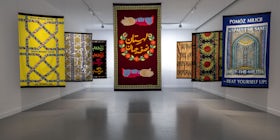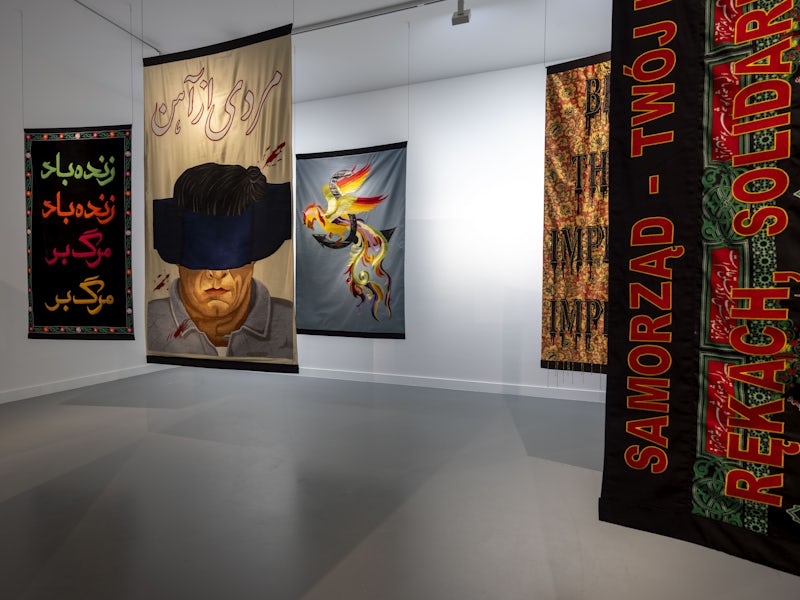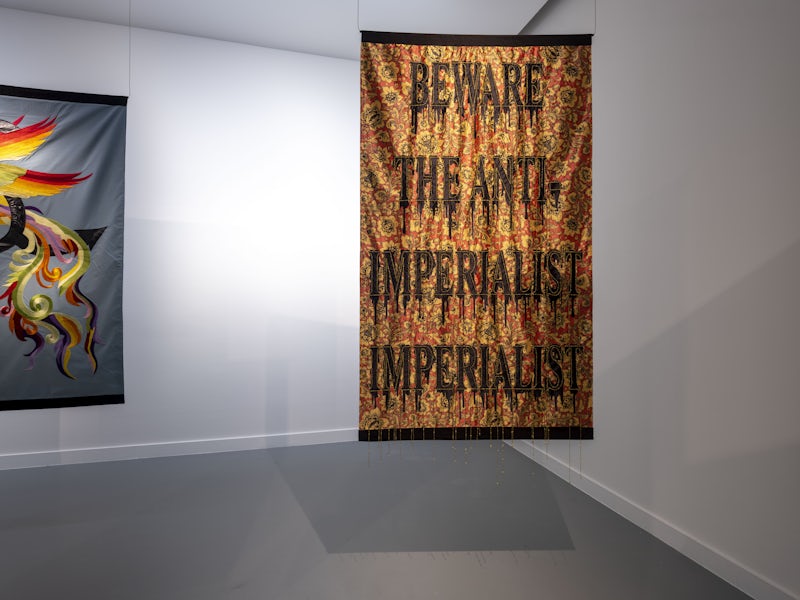
Donations to the M HKA: the case of Slavs and Tatars
The work Friendship of Nations: Polish’ Shi’te Showbiz by Slavs and Tatars is currently on display in a collection presentation. It consists of 10 banners that explore the connection between Polish and Iranian heritage. It was donated to the M HKA last year by German collector Christian Kaspar Schwarm. Why did he choose to donate this work to the museum? And how does the M HKA handle donations in general? An explanation.

Through his organisation Schwarm Projects, German consultant Christian Schwarm assists companies in developing their future strategy, positioning or branding. He also has a small art collection and is founder and partner of ‘Independent Collectors’, a global platform of art lovers and collectors. This platform connects private art collections worldwide and presents their activities to an interested public.
Initially, however, Schwarm’s love for art was not so obvious. As a young lad from a rural area in Southern Germany, he first moved to Stuttgart, then to Berlin. After having started collecting art a few years before, he there met Payam Sharifi – an Iranian-American researcher-writer who speaks as many as 5 languages. Together with Kasia Korczak he founded the artist collective Slavs and Tatars. Schwarm and Sharifi became roommates, and soon good friends. Slavs and Tatars’ work sparked Scharm’s love for contemporary art even further: the first work of Slavs and Tatars Schwarm acquired is also the very one he is now donating to the M HKA.
Focus on Eurasia
The artwork Friendship of Nations: Polish Shi’ite Showbiz (2011) consists of ten fabric cloths. It is part of a broader research project that uncovers the connection between Polish and Iranian heritage, and more specifically between the Islamic Revolution in 1979 and the Polish trade union movement Solidarność in the 1980s. Both events encapsulate a major geopolitical narrative from the recent past: Islamic modernism and communism. The banners have distinct titles, and as a whole they highlight the revolutionary power of craft and folklore. The installation reconsiders craft objects and practices as carriers of history, political emancipation and ideology.
Initially, Scharm set out to purchase just one single banner, but eventually he felt it was important to keep them together as one body of work. As a real art lover, he wants to actually live with the pieces he fell in love with. However, as this installation is quite large, living with and caring for it became too challenging and he therefore decided to donate it to an outstanding institution where it could be shown and seen by an interested public. In 2021, Slavs and Tatars was also invited to be included in the Eurasia exhibition at M HKA. Conscious of the fact that the M HKA collection is particularly focused on the Eurasian region, Sharifi advised Schwarm to donate the work to this specific museum. This is how the banners ended up in Antwerp. Given the current Iranian political context, it felt quite evident to almost immediately dedicate a collection presentation to Friendship of Nations: Polish Shi’ite Showbiz.

Art as public domain
Sometimes, it is not immediately clear at the time of donation at which occasion or context a work might best be shown. A few years ago, for instance, the M HKA was given a small house by Nikita Kadan: Будиночок велетнів / Small House of Giants (2012). The work had never been shown before, the interior was in need of restoration and the museum staff was not yet sure in which exhibition it might fit. Nevertheless, this was an important artist whose work fitted within the collection profile. The donation was accepted, and eventually the work was given a pivotal place in Imagine Ukraine (2022), a touring exhibition initiated by the PinchukArtCentre in Kiev and the M HKA.
Donations end up in the museum collection for various reasons. Many donations stem from the desire for art to become public domain. In some cases, an artist donates work he has created for an exhibition. Finally, certain donations result from a structural collaboration with an estate or collectors.
Donations are particularly important for a museum, especially when its acquisition budget is limited. However, it is neither practical nor financially feasible to accept all the works offered to the M HKA. Because of their size, some works take up too much storage space, they are excessively expensive to restore or do not fit the collection profile. Certain donors impose conditions that the museum cannot always meet, for instance that the donation must be permanently on display. The M HKA has a workgroup for acquisitions, which includes the general director, the curatorial team and the staff of the collection department. Together, they prepare a report in which they outline all the arguments for accepting or declining a particular work. Ultimately, the Board of Directors decides whether or not to accept a donation.
Friendship of Nations: Polish Shi’te Showbiz by Slavs and Tatars can be visited until 30 April.



